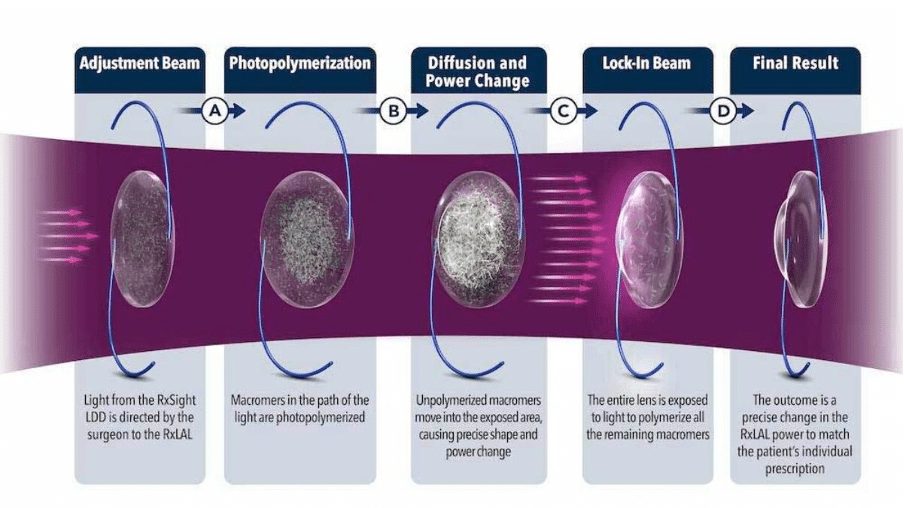Light-Adjustable Lens are a game-changing advancement in cataract surgery technology. These lenses give patients something unique – the ability to customise their vision after the surgery is complete. The FDA has approved these lenses as the only IOL that doctors can adjust post-surgery. This breakthrough technology has transformed patient expectations for vision quality after cataract procedures. Research shows that patients using light adjustable lenses are 200% more likely to achieve 20/20 vision without glasses compared to standard monofocal implants.
You need to know if this advanced solution matches your specific vision needs. The procedure lets you get personalised vision correction that could reduce your need for glasses. This option works great for certain patients. People with astigmatism of .75 diopters or higher might find this custom eye surgery especially helpful. The technology also appeals to detail-oriented patients who want precise vision. Surgeons can fine-tune the results instead of just relying on their initial calculations.

What Makes Light Adjustable Lenses Unique?
Light adjustable lenses revolutionise cataract surgery by knowing how to fine-tune vision after your procedure. This breakthrough technology stands apart from conventional lens options available today.
Customisation after surgery
Standard intraocular lenses stay fixed once implanted, but light adjustable lenses let doctors tailor vision correction to your exact needs. Your ophthalmologist can adjust these lenses to boost your vision based on real experience once your eye heals. Clinical studies showed that patients using light adjustable lenses are twice as likely to achieve 20/20 vision without glasses compared to standard monofocal IOLs.
Lens adjustments begin 2-3 weeks after your original procedure. You’ll get a chance to preview and compare different visual outcomes before picking what works best for you. The optimal vision usually takes 3-5 light treatments, and the customisation process typically needs 4-6 weeks to complete.
Photosensitive material and UV light response
This innovative technology’s core is a special photosensitive material that makes up the lens. The unique silicone matrix contains light-sensitive molecules (macromers) that react to ultraviolet light. A Light Delivery Device (LDD) creates precise UV light patterns that make these molecules form polymers, which changes the lens’s curve and refractive power.
Your surgeon can fix various vision problems through this non-invasive approach. These include nearsightedness, farsightedness, and astigmatism up to 0.75 diopters. The newer LAL 2.0 adds an enhanced UV absorber (ActivShield™) to its silicone matrix that protects better against environmental UV exposure.
Comparison with traditional and premium IOLs
Traditional IOLs’ biggest problem is their fixed power that can’t change after implantation. Premium options like multifocal lenses determine your vision outcome once they’re in place.
Light adjustable lenses provide refractive stability six times better than typical corneal refractive procedures. These lenses are a great choice for patients with complex visual needs or those who’ve had LASIK or PRK procedures. LALs excel at fixing leftover refractive errors with exceptional precision—matching LASIK-like accuracy in cataract surgery.
How the Light Adjustable Lens Procedure Works
The light adjustable lens procedure combines traditional cataract surgery with innovative post-operative customisation. Patients can prepare better for this advanced treatment option by understanding what happens throughout this trip.
Original cataract surgery and lens implantation
The surgical procedure starts just like standard cataract surgery. The surgeon removes the cloudy natural lens and replaces it with the light adjustable lens. This original operation takes 15-20 minutes per eye. Surgeons usually operate on one eye first and perform surgery on the second eye a few weeks later for patients who need treatment in both eyes. A small incision allows the photosensitive LAL implantation, which sets the stage for unique customisation.

Light treatment sessions and timeline
Your customisation trip starts approximately three weeks after surgery when your eye heals and vision stabilises. You’ll sit in front of a specialised Light Delivery Device that delivers controlled UV light to reshape your lens without invasion. Each treatment lasts about 90 seconds without any pain. Your surgeon uses detailed vision testing and precisely programmed UV light patterns to adjust different parts of the lens. The lens becomes more or less curved based on your visual needs.
Lock-in process and UV protection glasses
Your surgeon will perform two final ‘lock-in’ treatments after achieving your desired vision outcome. These treatments permanently set your customised prescription and ensure lifelong vision stability. UV-protective glasses must be worn during all waking hours throughout the adjustment period. You’ll receive three specialised pairs of glasses. These include tinted glasses for outdoors, clear glasses for indoors, and clear readers for near vision tasks. Each pair protects your light-sensitive lens from uncontrolled changes.
Expected number of visits and duration
The light adjustable lens trip requires between 3-5 total visits. This number includes 1-3 adjustment sessions plus two mandatory lock-in appointments. Visits happen about 1-2 weeks apart. The whole process from surgery to final lock-in takes 4-6 weeks. The procedure offers flexibility to ensure optimal results without strict deadlines.
Are You a Good Candidate for Light Adjustable Lens Implants?
Let’s explore what makes you a good candidate for a light adjustable lens by looking at several important factors that lead to successful outcomes.
Ideal eye health and vision goals
The best candidates for light adjustable lenses have cataracts but otherwise healthy eyes. Your pupils must dilate to at least 6mm for proper adjustment treatments. You should be free from macular disease and have no history of herpes eye infections. Most suitable patients are between 40-80 years old and have astigmatism of at least 0.75 diopters.
Astigmatism and previous LASIK/PRK
Previous refractive surgery like LASIK or PRK might make you an excellent candidate for light adjustable lenses. These lenses work great for post-refractive surgery patients because traditional IOL calculations don’t work as well in these eyes. Studies show that post-LASIK patients with light adjustable lenses achieved results within ±0.25D in 74% of eyes and within ±0.50D in 97% of eyes. This is a big deal as it means better outcomes than conventional lenses.
Lifestyle compatibility and commitment to follow-ups
Your dedication to follow-up appointments plays a vital role. The adjustment process needs multiple visits, and you’ll typically need 3-5 total appointments to complete your light adjustable lens treatment. You must also wear UV protective glasses during all waking hours throughout the treatment period.
Light-Adjustable Lens (LAL) Implants aren’t right for everyone. They could be perfect if you want precise, customizable vision after cataract or lens replacement surgery. LALs work best for patients without major eye disease or scarring. Want to know if you’re eligible? Book a consultation with our trusted eye surgeons at Precision Vision London for expert guidance tailored to your eye health.
Who may not qualify for LAL surgery
Some conditions will disqualify you from LAL surgery. You shouldn’t get LALs if you take medications that increase UV light sensitivity such as tetracycline, doxycycline, psoralens, and several others. Patients taking retina-toxic medications like tamoxifen should avoid this lens. LALs won’t work if you have nystagmus because you can’t maintain steady fixation during treatment. Advanced glaucoma or significant retinal diseases might also make you unsuitable for light adjustable lenses.
Benefits and Considerations of Choosing LAL
Light adjustable lenses give you better control over your vision outcomes than regular options. These lenses come with some amazing benefits.
Tailored vision correction
The numbers speak for themselves – 92% of patients with light adjustable lenses get exactly the vision they want. These amazing results happen because doctors can adjust your vision based on your real-life experience instead of pre-surgery guesses. Your surgeon can fine-tune your vision precisely, down to 0.25 diopters of correction.
Reduced dependence on glasses
Most patients don’t need glasses for their daily activities after getting light adjustable lenses. Research shows you’re twice as likely to achieve 20/20 vision without glasses compared to standard monofocal lenses. Living without corrective eyewear can improve your life’s quality.
Flexibility during recovery
The adjustment process lets you test your vision in everyday situations before settling on your final prescription. You can share your thoughts about how well you see when reading, driving or doing your favourite hobbies.
Light adjustable lens pros and cons
These lenses give you the best customisation options, but you’ll need several follow-up visits over 4-6 weeks. You must wear UV protective glasses whenever you’re awake during this time. The cost runs higher than standard IOLs and insurance usually doesn’t cover it. The unmatched precision makes it worth considering for anyone who wants the best possible vision.
Conclusion
Light adjustable lenses mark a breakthrough in cataract surgery technology. These lenses can be customised after implantation, offering precision that standard intraocular lenses can’t match. This revolutionary option doubles your chances of achieving 20/20 vision without glasses compared to conventional lenses.
You get more than just better visual acuity. The adjustment process lets you test different visual settings in real-life conditions before finalising your prescription. This personalised approach works great if you have astigmatism or went through LASIK or PRK procedures earlier.
Your eye health and dedication to the process determine LAL implant success. You’ll need several follow-up visits over weeks and must wear UV protective glasses consistently. Your lifestyle and availability for appointments should shape your decision.
LAL technology is the closest you can get to “fine-tuning” your vision after cataract surgery. Want to know if you qualify? Book a consultation with our trusted eye surgeons at Precision Vision London to get expert guidance for your eye health. The precision and customisation that light adjustable lenses provide make them worth checking out if you want the best visual outcomes from cataract surgery.
Key Takeaways
Light-adjustable lenses offer a revolutionary approach to cataract surgery, providing customisation capabilities that traditional lenses simply cannot match. Here are the essential insights for potential candidates:
- Light-adjustable lenses are the only FDA-approved IOLs that can be customised after surgery, offering twice the likelihood of achieving 20/20 vision without glasses compared to standard lenses.
- Ideal candidates include patients with astigmatism of 0.75 diopters or greater, those who’ve had previous LASIK/PRK surgery, and individuals seeking precise vision correction.
- The procedure requires 4-6 weeks of follow-up visits and mandatory UV protective glasses during all waking hours throughout the adjustment period.
- Patients can test different visual settings in real-world conditions before finalising their prescription, allowing unprecedented personalisation of vision outcomes.
- Certain conditions disqualify candidates, including UV-sensitive medications, nystagmus, advanced glaucoma, or significant retinal diseases.
This advanced technology represents a paradigm shift from “one-size-fits-all” to truly personalised vision correction, making it particularly valuable for discerning patients who prioritise optimal visual outcomes over convenience.
FAQs
Q1. Who is an ideal candidate for light-adjustable lens implants? Ideal candidates include individuals with cataracts, those with astigmatism of 0.75 diopters or greater, and patients who have previously undergone LASIK or PRK. Healthy eyes, the ability to commit to follow-up appointments, and a desire for precise vision correction are also important factors.
Q2. What makes light-adjustable lenses unique compared to traditional intraocular lenses? Light-adjustable lenses are the only FDA-approved lenses that can be customised after cataract surgery. They offer the ability to fine-tune vision based on real-world experience, potentially doubling the chance of achieving 20/20 vision without glasses compared to standard lenses.
Q3. How long does the light-adjustable lens procedure take from start to finish? The entire process, from initial surgery to final lock-in, typically takes 4-6 weeks to complete. This includes the initial cataract surgery, followed by 3-5 adjustment sessions spaced about 1-2 weeks apart, and concluding with two mandatory lock-in appointments.
Q4. Are there any special precautions required after receiving light-adjustable lenses? Yes, patients must wear UV-protective glasses during all waking hours throughout the adjustment period, which lasts several weeks. This includes specialised tinted glasses for outdoors, clear glasses for indoors, and clear readers for near vision tasks.
Q5. What are the potential drawbacks of choosing light-adjustable lenses? While offering superior customisation, light-adjustable lenses require multiple follow-up visits over several weeks and consistent wearing of UV protective glasses. They also tend to be more expensive than standard intraocular lenses and are typically not covered by insurance.
Authors & Reviewer
-
 Olivia: Author
Olivia: AuthorHi, I'm Olivia, a passionate writer specialising in eye care, vision health, and the latest advancements in optometry. I strive to craft informative and engaging articles that help readers make informed decisions about their eye health. With a keen eye for detail and a commitment to delivering accurate, research-backed content, I aim to educate and inspire through every piece I write.
-
 Dr. CT Pillai: Reviewer
Dr. CT Pillai: ReviewerDr. CT Pillai is a globally recognised ophthalmologist with over 30 years of experience, specialising in refractive surgery and general ophthalmology. Renowned for performing over 50,000 successful laser procedures.

